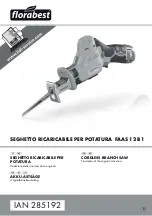
11
until the blade attains full speed. Now simply move the
tool forward over the workpiece surface, keeping it flat
and advancing smoothly until the sawing is completed.
To get clean cuts, keep your sawing line straight and your
speed of advance uniform. If the cut fails to properly follow
your intended cut line, do not attempt to turn or force the
tool back to the cut line. Doing so may bind the blade and
lead to dangerous kickback and possible serious injury.
Release switch, wait for blade to stop and then withdraw
tool. Realign tool on new cut line, and start cut again.
Attempt to avoid positioning which exposes operator to
chips and wood dust being ejected from saw. Use eye
protection to help avoid injury.
Rip fence (Guide rule) (optional
accessory) (Fig. 27)
The handy rip fence allows you to do extra-accurate
straight cuts. Simply slide the rip fence up snugly against
the side of the workpiece and secure it in position with the
clamping screw on the front of the base. It also makes
repeated cuts of uniform width possible.
MAINTENANCE
CAUTION:
• Always be sure that the tool is switched off and the
battery cartridge is removed before carrying out any
work on the tool.
•
Clean out the upper and lower guards to ensure
there is no accumulated sawdust which may
impede the operation of the lower guarding
system.
A dirty guarding system may limit the proper
operation which could result in serious personal injury.
The most effective way to accomplish this cleaning is
with compressed air.
If the dust is being blown out of
the guards be sure the proper eye and breathing
protection is used.
• Never use gasoline, benzine, thinner, alcohol or the
like. Discoloration, deformation or cracks may result.
Adjusting for accuracy of 0° and 45° cut
(vertical and 45° cut) (Fig. 28 & 29)
This adjustment has been made at the factory. But if it is
off, adjust the adjusting screws with a hex wrench while
inspecting 0° or 45° the blade with the base using a
triangular rule or square rule, etc. Use the 45° stopper for
adjusting 45° angle.
Adjusting bevel guide (Fig. 30)
The bevel guide has been factory adjusted. But if it is off,
you can adjust it as the following procedure.
To adjust the bevel guide, loosen the two screws. Align
the 0° line on the bevel guide with the guide on the base
when the base is set to 0° angle.
To maintain product SAFETY and RELIABILITY, repairs,
any other maintenance or adjustment should be
performed by Makita Authorized Service Centers, always
using Makita replacement parts.
OPTIONAL ACCESSORIES
CAUTION:
• These accessories or attachments are recommended
for use with your Makita tool specified in this manual.
The use of any other accessories or attachments might
present a risk of injury to persons. Only use accessory
or attachment for its stated purpose.
If you need any assistance for more details regarding
these accessories, ask your local Makita Service Center.
• Saw blades
• Rip fence (Guide rule)
• Guide rail
• Guide rail adapter
• Rule bar
• Dust nozzle
• Hex wrench
• Makita genuine battery and charger
NOTE:
• Some items in the list may be included in the tool
package as standard accessories. They may differ
from country to country.
Noise
ENG905-1
The typical A-weighted noise level determined according
to EN60745:
Sound pressure level (L
pA
): 83 dB (A)
Sound power level (L
WA
): 94 dB (A)
Uncertainty (K): 3 dB (A)
Wear ear protection.
Vibration
ENG900-1
The vibration total value (tri-axial vector sum) determined
according to EN60745:
Work mode: cutting wood
Vibration emission (a
h,W
): 2.5 m/s
2
or less
Uncertainty (K): 1.5 m/s
2
ENG901-1
• The declared vibration emission value has been
measured in accordance with the standard test method
and may be used for comparing one tool with another.
• The declared vibration emission value may also be
used in a preliminary assessment of exposure.
WARNING:
• The vibration emission during actual use of the power
tool can differ from the declared emission value
depending on the ways in which the tool is used.
• Be sure to identify safety measures to protect the
operator that are based on an estimation of exposure in
the actual conditions of use (taking account of all parts
of the operating cycle such as the times when the tool
is switched off and when it is running idle in addition to
the trigger time).
For European countries only
ENH101-18
EC Declaration of Conformity
Makita declares that the following Machine(s):
Designation of Machine:
Cordless Circular Saw
Model No./Type: DHS680
Conforms to the following European Directives:
2006/42/EC
They are manufactured in accordance with the following
standard or standardized documents:
EN60745












































